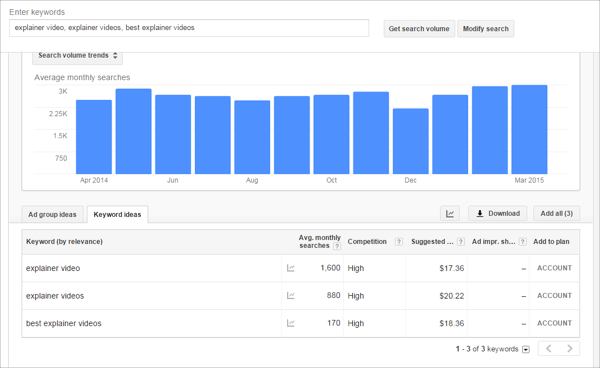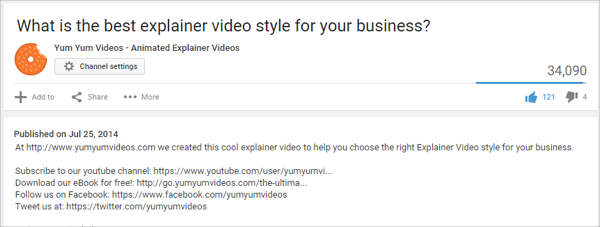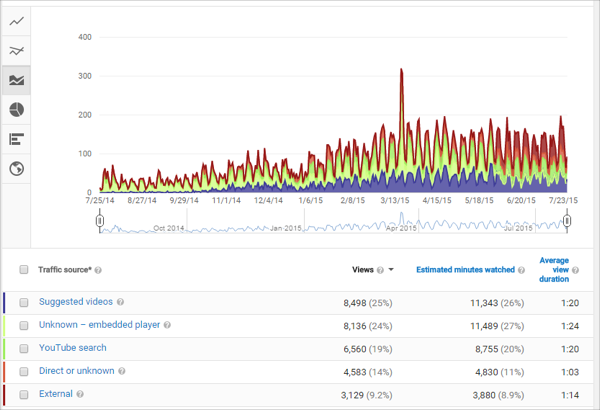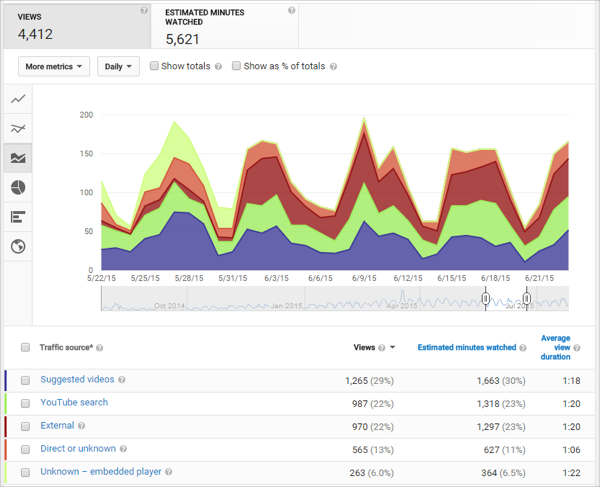The fact is; being visible on YouTube has become essential to any company that wants to promote their brand through video marketing.
Processing over 3 billion searches each month, YouTube is second only to Google itself as a search engine. Its popularity is changing the way we search online, and it directly influences the way we’re consuming information. Youtube provides businesses the opportunity to effectively connect with people interested in their products and services.
The problem is that being found by your potential customers on YouTube isn’t that easy – you have to beat millions of competitors with larger budgets and brighter videos.
Being visible on YouTube and ranking high in its search results requires thorough search engine optimization (SEO), a wise distribution plan and, above all, a quality marketing video.
Today you’ll learn the basics on how to rank number one on YouTube with your own video. But I’ll not just describe how to do it; I’ll explain and demonstrate each step by using a successful case study from Yum Yum Videos: their explainer video got ranked number one on YouTube under the most valuable business keywords in just 3 months, so it will serve us as a clear example on each step.
You can also get the free step-by-step eBook “How To Rank #1 on YouTube” which expands on this effective strategy.
Now let’s start this exciting video SEO journey with the first question:
Why YouTube?
What many people don’t take into account is that YouTube is also a massive social network; it actually happens to be the world’s 3rd largest social network, behind Facebook and Twitter.
This alone makes YouTube a perfect spot on the web to promote your brand.
But the thing is, you can’t really be on YouTube without a video, and even then: you won’t rank high in the search engine without a quality marketing video, simply because yours need to stand out among the 4 billion videos that are watched on it every day… and that leads us to the next point.
The relevance of having a quality video
The problem with marketing videos is that you need to make a quality one, or else YouTube will send it to the dark bottom of its page results, even if you spend your whole budget on advertising.
Why is that? Because YouTube cares a lot about complete video views, and the amount of time people spend watching a video is one of the factors YouTube cares about when setting up its SERP (search engine results pages). And, let’s face it; no one would care to watch a video all the way through if it’s not well made!
Take a look at “What is the best explainer video style for your business?”, the quality animated video that made Yum Yum Videos rank number one on YouTube:
Now check out this simple YouTube Analytics graph to see how long viewers spent watching that video:

The graph reveals that the video reached a high audience retention rate with almost 1:20 minutes per viewer on average. That doesn’t cover the entire video, but it’s a great number, considering people’s average attention span is just 8 seconds.
You should keep in mind that only a quality marketing video makes people engaged and willing to watch it completely.
When we say quality, we’re talking about storytelling, design and animation; something that only a professional video production company with qualified experts in each production area can offer.
Long story short – you need a high-quality video to make your SEO strategy work and get your marketing objectives covered.
Video SEO and keyword planning
Ok, so you have a quality marketing video and you want it to climb up the YouTube results page. What you need now is a clever video SEO strategy and some wise keyword planning in order to optimize your video’s performance on the site.
Let’s learn the best practices in this area:
1. Keywords
First of all, you should learn which words from your business niche come up frequently on YouTube and how many people usually search for a particular word by using a SEO tool such as Google’s keyword planner.
In the case of Yum Yum Videos the most relevant business keyword is “explainer video” with over 1,600 monthly search results in the US:

However, don’t fight over the most searched keyword terms because that would be really hard to rank for. I recommend using longtail keywords instead: they’re longer and contain more specific phrases, which do include your main keywords but have less people fighting over them.
In our case study, the longtail keyword is “the best explainer videos”.
Longtail keywords drive precise views from potential customers way faster, helping your video to rank under the main keyword too. Once you find your own, don’t forget to use them everywhere in YouTube: titles, descriptions, tags, etc.
2. Titles
Titles help people get what your video is about before hitting the play button, so it’s vital to place your keywords in it.
Here’s the title from our case study:

Now don’t forget to keep your titles brief and direct. I recommend using less than 70 characters, because longer titles are cut off in the YouTube results page.
On the other hand, try to avoid writing titles that don’t represent the true content in your video. Tricky or misleading titles cause a huge drop-off that will reduce your video’s performance.
3. Thumbnails
Thumbnails are essential SEO features because they act as the only preview for your video on theYouTube results page and suggestions. Besides, it’s proven that a spot-on thumbnail will invite more people to press play on your video, but a badly-chosen one will drive them away.
Therefore, you should choose your thumbnails carefully.
Here you can get a glimpse of the early-considered thumbnails from our case study (the upper-left one became the final choice):

As with your title, don’t cheat with a misleading thumbnail. People hate tricky thumbnails.
On the other hand, use only hi-resolution images (640×360 pixels at a minimum) and make sure that the thumbnail looks good in both small and large sizes and on different devices (TV, iPad and desktop PC).
If your image is not attractive enough, people simply won’t click on it.
4. Descriptions
Descriptions explain what your marketing video is about. You need to make them short and accurate (around 2 sentences are perfect) but don’t forget to use your business keywords.
It’s also mandatory to include a link to your own site within those two sentences, and you can add links to your social media channels as well. These actions will increase your website traffic and create a great opportunity to drive potential customers to your brand.
Check out the description in our case study:

5. Call-to-action
Now, for this strategy to drive concrete marketing results apart from views and SEO purposes (for example downloading your content, subscribing to your newsletter, visiting your site, etc.) you need to encourage your viewers to take action by adding a clear call-to-action in the form of a clickable button.
Or you can use the YouTube Cards feature instead (which is a sidebar call-to-action), in order to lead your viewers to your website, landing page or any other video of yours that’s hosted on YouTube:

Distribution and link building
In order to set up its results pages, YouTube considers all the websites where your video is embedded and played on, and also takes into account the amount of YouTube views that come from those sites.
Then, if you really want to enhance your Video SEO strategy, you need to distribute your video in the right spot for potential customers to watch it.
Let me quickly describe those spots:
1. YouTube ads
Investing some money in YouTube Ads (aimed to the right target audience) can give an initial boost to your video marketing campaign, making you clinch a first bunch of viewers and allowing YouTube to start measuring your videos’ performance.
However, after that first push, it’s better to rank organically on YouTube, because it gives your video more credibility and fairness.
2. Link building
You must drive your marketing video forward to make it rank number one on YouTube. Besides embedding your video on your blog (and other people’s blog) use it in landing pages, press releases, email marketing campaigns and social media posts, to then measure its overall performance.
Remember that your video can turn into a powerful marketing tool to suit your online campaigns.
Here you can analyze the visit rates and sources from our case study:

As you can see, views came almost exclusively from the embedded player source -in light green- during the first 3 months (that’s blogging and guest blogging playback).
But then YouTube’s organic visits -in purple and dark green- (those are direct searches and video suggestions playbacks) began to rise, because that’s when the video started to rank number one on YouTube’s search engine results page.
Eventually, YouTube’s searches and suggestions’ playbacks beat the embedded player source:

From then on, the animated video started to gain 300% more views every day, comparing it with day 1. Views keep growing by a monthly 20% on average. As today, the video has over 30,000 views and holds the number one position under Yum Yum Videos’ most valuable keywords.
Now you’re ready to build up your own videos and set up a wise video SEO strategy to start ranking high on YouTube’s search engine results page!
Remember that you can download Yum Yum Videos’ free eBook to widen this knowledge and learn how to craft a quality marketing video to compete with.
